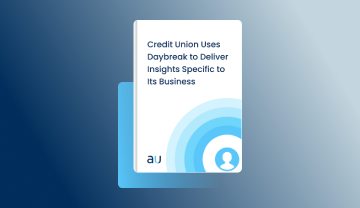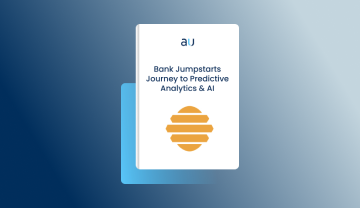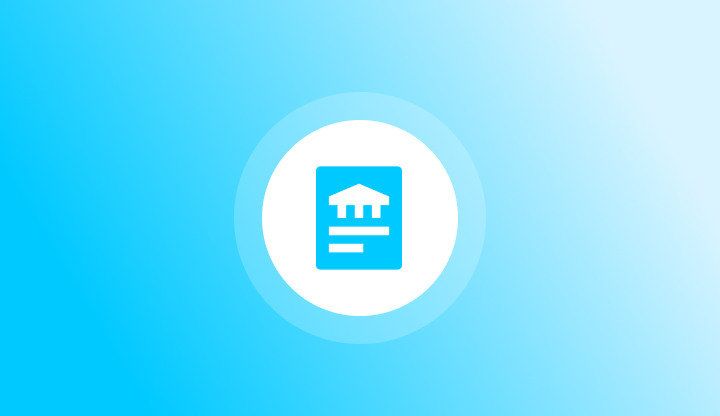2021 Michigan Bankers Association Annual Convention
Michigan Bankers Association Annual Convention
Grand Hotel, Mackinac Island
Aunalytics is attending the 2021 MBA Annual Convention as a Silver Sponsor
Aunalytics is pleased to once again attend the Michigan Bankers Association Annual Convention at Mackinac Island. We are excited to introduce keynote speaker Kyle Carpenter, the youngest living recipient of the Medal of Honor. We look forward to showcasing our Daybreak analytic database – built specifically to bring data-driven, AI-powered answers to community banks’ most important business questions.
For more information on the event, or to register, please click here.

Credit Union Uses Daybreak to Deliver Insights Specific to Its Business
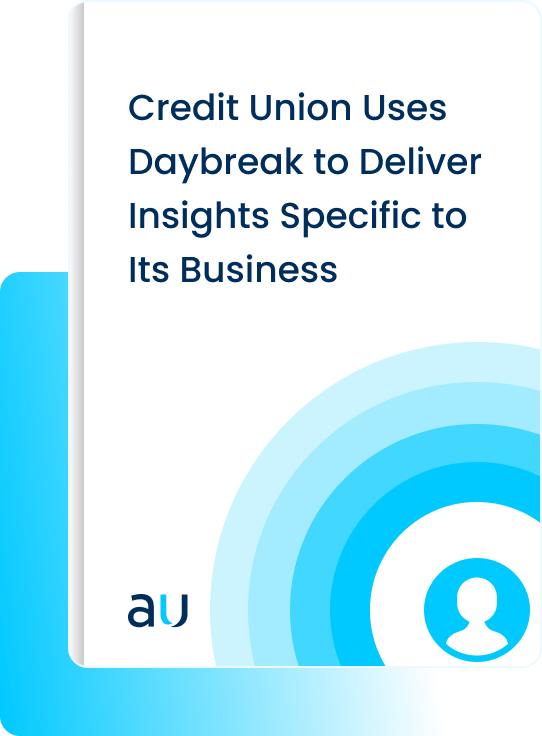
Case Study:Credit Union Uses Daybreak to Deliver Insights
The President of a Michigan credit union wanted to incorporate data analytics for better executive decision-making. As new community banks and credit unions kept moving to his region, he was concerned about the credit union’s ability to compete and distinguish themselves from other local, white glove financial services options. To meet this goal, the president wanted a dashboard to view all member data in one place, but he did not know where to begin.
This case study summarizes how the credit union was able to laser in on what it needed based upon their failed attempts. It needed a solution with a focus on reporting to the end user to deliver insights that would give business outcomes. It needed Daybreak™.
Aunalytics is a data platform company. We deliver insights as a service to answer your most important IT and business questions.
Featured Content
Nothing found.
Provident Bank Case Study
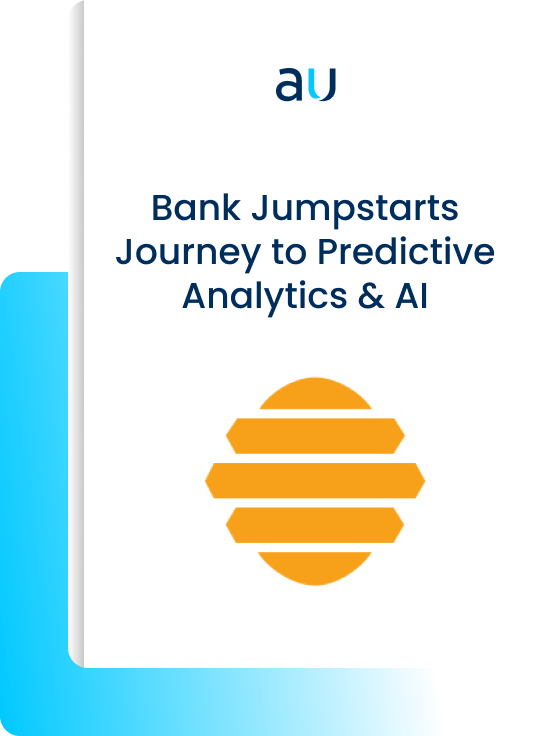
Bank Jumpstarts Journey to Predictive Analytics & AI
Provident Bank, a mid-sized bank with $10 billion in assets, is the oldest community bank in New Jersey with branches across two states. Although they have successfully met their customer’s needs for more than 180 years, they knew that they needed to invest in technologies today that would carry them into the future.
Aunalytics is a data platform company. We deliver insights as a service to answer your most important IT and business questions.
Featured Content
Nothing found.
Insurance Company Lacks Customer-Centric View of Data
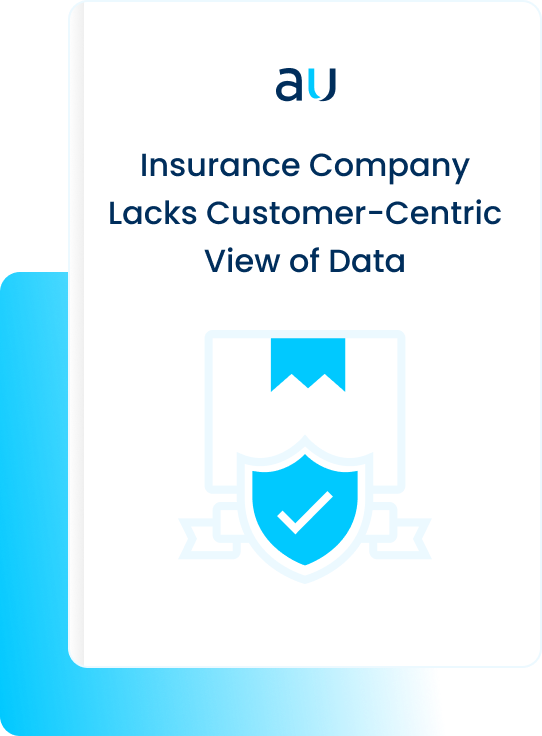
Insurance Company Lacks Customer-Centric View of Data
Aunalytics is a data platform company. We deliver insights as a service to answer your most important IT and business questions.
Featured Content
Nothing found.
Aunalytics Introduces Next-Generation Daybreak for Financial Services
Empowering Users with Advanced Analytics and Valuable Business Insights to Accelerate Competitive Advantage
South Bend, IN (March 23, 2021) – Aunalytics, a leading data platform company delivering Insights-as-a-Service for enterprise businesses, today introduced its next generation of DaybreakTM for Financial Services designed for mid-sized banks and credit unions. The enhanced solution empowers community financial institutions with advanced analytics and valuable business insights to improve customer relationships, strategically deliver new products and services through data-driven campaigns and drive competitive advantage with Aunalytics’ side-by-side digital transformation model.
As with many businesses, financial institutions have a plethora of data that is typically siloed across many systems throughout the organization. Aggregating and integrating this data is a major challenge that can be difficult and time-consuming, if not nearly impossible, such as with transactional data. According to leading analysts, 70 percent of big data and analytics deployments will fail to meet cost savings and revenue generation objectives due to skill and integration challenges.
“We have data; every bank has data—tons of it. What we didn’t have was a way to integrate all this data into something useful,” said John Kamin executive vice president and chief information officer, Provident Bank. “We embarked on a journey that would not only allow us to turn data into information but enable us to look forward with predictive analytics and AI capabilities. Aunalytics helped us jumpstart that vision.”
Built from the ground up for mid-sized banks and credit unions, Daybreak for Financial Services is a cloud-native data platform with advanced analytics that empowers users to focus on critical business outcomes. The solution cleanses data for accuracy, ensures data governance across the organization, and employs artificial intelligence (AI) and machine learning (ML) driven analytics to glean customer intelligence and insights in focus from relevant business information. With daily insights powered by the Aunalytics® cloud-native data platform, industry intelligence, and smart features that enable a variety of analytics solutions for fast, easy access to credible data, users can find the answers to such questions as:
- Who are my current customers that have a loan and not a deposit account?
- Who are my most profitable members?
- Who are my customers at risk for churn?
- Which loans were modified from the previous day?
- Who are my current members with a HELOC that are utilizing less than 25% of their line of credit?
“As customer interactions become increasingly digital, community banks and credit unions are losing the competitive advantage that local, personalized, white-glove service has traditionally afforded them and, at the same time, they lack valuable business insights that untapped data could provide to improve their operations,” said Katie Horvath, VP of Marketing and Communications, Aunalytics. “Daybreak for Financial Services offers an opportunity to turn that around and regain advantage with the ability to target, discover and offer the right services to the right people, at the right time.”
New features in Daybreak for Financial Services include:
- Golden Record Assurance:
- Daybreak cleanses data for accuracy and governance and transforms disparate data forms and formats into a common language for building data models. Data fields and records are matched and merged into a golden record for a single source of truth, ready for analytics.
- The industry-intelligent data mart is designed specifically for banks and credit unions, allowing them to automatically find customer data across the organization such as lending, mobile banking, ATM, CRM, wealth and trust. Extracting company data from all business units that is accurate and streamed in real-time, enables better decision making. Aggregated data reveals a 360-degree view of customer behaviors and insights for data-driven campaigns and greater customer and product targeting capabilities.
- Smart Features™ :
- Aunalytics data scientists create high value data fields derived from a company’s internal data and added to data models capable of answering industry and functional questions. Business users have access to actionable data, enriched with Smart Features, to answer impactful questions for the first time. For example, if a banking customer has improved a credit score and is now in the “excellent” range, the bank can take action and let the customer know that if interested in a home equity loan, s/he qualifies for low interest rates.
- In addition, Daybreak offers a significant advantage with automated data enrichment and pre-built connectors to most major core systems such as CRMs, loan and mortgage systems, and other heavily utilized financial industry applications. Mid-sized banks and credit unions now have access to external data, allowing them to understand more about their customers’ relationships with other companies and identify products and services that customers might be interested in. This presents opportunities that may have otherwise been missed – learning that a customer has outside investment and mortgage accounts might prompt outreach to the customer to make a switch.
- Natural Language Answers™ and Insights:
- Daybreak is built for the non-technical business user to query data using NLP searching, and visually display golden records of data, analytics results, and insights. Users do not need to know SQL, computer coding, database technical knowledge or IT expertise to find answers to their most important business and IT questions.
- Insights allows users to better understand the information in their data by creating visualizations of their query results. Visualizations can be easily configured and viewed as intuitive graphics, not through complex database filtered lists of endless fields, so users can answer important business questions about customers.
Tweet this: .@Aunalytics Introduces Next-Generation Daybreak for Financial Services, Empowering Users with Advanced Analytics and Valuable Business Insights to Accelerate Competitive Advantage
#Dataplatform #Dataanalytics #Dataintegration #Dataaccuracy #ArtificialIntelligence #AI #Masterdatamanagement #MDM #DataScientist #MachineLearning #ML
About Aunalytics
Aunalytics is a data platform company delivering answers for your business. Aunalytics provides Insights-as-a-Service to answer enterprise and midsized companies’ most important IT and business questions. The Aunalytics® cloud-native data platform is built for universal data access, advanced analytics and AI while unifying disparate data silos into a single golden record of accurate, actionable business information. Its DaybreakTM industry intelligent data mart combined with the power of the Aunalytics data platform provides industry-specific data models with built-in queries and AI to ensure access to timely, accurate data and answers to critical business and IT questions. Through its side-by-side digital transformation model, Aunalytics provides on-demand scalable access to technology, data science, and AI experts to seamlessly transform customers’ businesses. To learn more contact us at +1 855-799-DATA or visit Aunalytics at https://www.aunalytics.com or on Twitter and LinkedIn.
PR Contact:
Sabrina Sanchez
The Ventana Group for Aunalytics
(925) 785-3014
sabrina@theventanagroup.com
Daybreak’s Built-in Industry Intelligence Leads to Faster, More Actionable Insights for Banks and Credit Unions
When choosing a piece of technology for your business, it is important to consider technical specs, features, and performance metrics. But that isn’t all that matters. Even though a product or solution may fit all of your technical requirements, it might not be a great fit for your bank or credit union. As an all-in-one data management and analytics platform, Daybreak is a uniquely strong contender on technical abilities alone, but it also offers features specifically engineered to answer the most prevalent and actionable questions that banks and credit unions currently ask, or should be asking themselves, every day. This is made possible through its built-in industry intelligence.
Industry Intelligence Increases Speed to Insights
Daybreak was developed specifically to help mid-market banks and credit unions compete, leveraging the same big data and analytics technologies and capabilities as the largest, leading institutions in the industry. We know that financial services organizations have a wealth of data—but not all of it is actionable, nor even accessible in its current state. We quickly break down data silos and integrate all the relevant data points from multiple systems; including internal and external, structured and unstructured.
It is Industry Intelligent because our experience knows the kinds of questions an institution needs to answer—that is why over 40% of the data in our model doesn’t exist in the raw customer data. These new data points are called Smart Features.
Over 40% of the data in the Daybreak model doesn’t exist in the raw customer data. It is engineered using Smart Features.
Data Enriched with Smart Features Provides Actionable Insights
One huge advantage that Daybreak offers banks and credit unions is automated data enrichment, through the use of Smart Features. Smart Features are newly calculated data points that didn’t exist before. Daybreak utilizes AI to generate these new data points which allow you to answer more questions about your customers than ever before. For example, Daybreak automatically converts unstructured transactional data into structured Smart Features—converting a long, confusing text string to a transaction category. A transaction that looks like this in the raw data…
| CHASE CREDIT CRD CHECK PYMT SERIAL NUMBER XXXXXXXX |
Is converted to this data point, which can be easily analyzed or used to filter and analyze:
| Customer Number | Account Number | Destination Category | Destination Name | Recurring Payment |
|---|---|---|---|---|
| 123 | 456 | Credit Card | Chase | Yes |
Another category of Smart Features are new values that are calculated based on existing data. For example, Daybreak’s AI scans transactional data and determine which branch is used most often by each individual. It can look at person’s home address and determine which branch is the closest to their home. The AI also scans transactional data for anomalies, and flags any unusual activities, which may indicate a fraud attempt, or a life change. For example, if an account suddenly stops showing direct deposits, perhaps that customer has changed jobs, or is in the process of switching to a different bank.
Since these Smart Features are automatically created, you can start asking actionable questions right away, without waiting for complicated analysis to be performed.
Daybreak has pre-built connectors to most of the major core systems, CRMs, loan and mortgage systems, and other heavily utilized financial industry applications. This means we can get access to your data faster, including granular daily transactional data, and automatically serve it back in a format that you can use to make data-driven decisions. We’ve figured out the difficult foundational part so you don’t have to spend months of development time building a data warehouse from scratch—you will begin getting insights right away.
Daybreak aggregates data from multiple sources, and allows you to receive actionable insights right away.
Scale your Team’s Industry Experience with Daybreak
One challenge that organizations face with any new initiative is how to transfer knowledge and collaborate across departments or locations. If one team member creates a useful analysis or process, it can be difficult to share with others who may want to look at the same type of information. Daybreak’s Query Wizard makes it easy to share intelligence across your business by providing pre-built queries for common banking questions and insights. We also update the pre-built queries regularly with new business-impacting questions as they are formulated. Lastly, in a click of a button, any query is available in SQL code, providing a huge head start to your IT team in more advanced work that they would like to do.
The Daybreak Advantage
Unlike other “one-size-fits-all” technology solutions, Daybreak has financial industry intelligence and AI built into the platform itself. It allows banks and credit unions easy access to relevant data quickly, and without investing excessive time and money to make it happen. With Daybreak, business users have access to actionable data, enriched with Smart Features, in order to start answering impactful questions they’ve never been able to before. Your entire organization can utilize industry-specific insights and collaborate on data analysis.
Daybreak is a game-changer for banks and credit unions. Start making better business decisions by effectively leveraging your data today.
Solving Data Challenges for Mid-Market Community Banks
Mid-market community banks and credit unions are facing increased expectations from customers and members. As technology advances across all industries, people expect a highly-personalized experience. To provide a customized customer journey, banks and credit unions must utilize the wealth of data that is available to them—basic account information, CRM data, transactions, loan data, and other useful sources.
However, this requires an institution to overcome a number of challenges, including siloed data, poor data quality and governance, use of stale, non-actionable data, manual retrospective reporting, and overall lack of necessary analytics tools and talent. Building a strong, scalable, and automated data management foundation is necessary to realize a digital transformation and ultimately meet customer expectations through actionable analytics insights. Thankfully, these challenges are not insurmountable, and we have outlined the various challenges and put forward guiding principles to help your organization overcome them.
Asking the Right Questions, at the Right Time
Having access to data is powerful, but only if you are asking the right questions. Some organizations have hundreds of dashboards, but few of the insights are actionable. Others have specific questions they’d like to answer, but no easy way to create custom queries or visualizations to dig deeper into the data. It is important to arm all users with the tools necessary to analyze data in order to take action. Users need to be given the ability to utilize relevant pre-built queries or build their own, filter data, segment customers and members, and create meaningful lists. This is also dependent on having a strong, centralized data repository, built for analysis, that gives access to timely and accurate data.
Choosing the Right Technology
While modern core systems and other business applications have their uses, they are not equipped to handle enterprise-wide analytics. These databases systems of record and are meant to handle transactions, and while ideal for collecting and modifying records in real-time, they are not able to meet the needs of querying and analytics. Furthermore, when data is spread across multiple systems, there must be a central repository to aggregate all of this data. A cloud-based next-gen data lake or data warehouse is the ideal option in this situation. They are easily queried and the structure lends itself to analytical applications, including machine learning, predictive analytics, and AI. By building a strong foundation, for BI and analytics, community banks and credit unions make a huge leap towards digital transformation and more closely competing with their larger industry peers.
Breaking Down Data Silos
Financial institutions have no shortage of data. However, that data is usually siloed across many systems throughout the organization. Aggregating and integrating that data is a major challenge that in the best case scenario, can be difficult and time-consuming, and at worst, nearly impossible (such as with transactional data). It can be especially challenging when working with vendor-hosted systems, such as your core, mortgage, loan origination, mobile/online banking, and CRMs. All of this data offers key details into customer behavior, so it is important to utilize all sources to get a complete picture of individuals, as well as the institution as a whole. This is why a singular data warehouse or data lake is essential for analysis and reporting. When all the data from various sources is ingested into this system, via internal connectors and external APIs, it is far easier to query and link the data to gain a 360-degree view of each customer or member, and discover insights you’ve never had access to before.
Ensuring Data Accuracy
Having a wealth of data and insights at your fingertips is only helpful if that data is accurate. Whenever data is entered into a system manually, it is an opportunity for mistakes to be made. If a name is misspelled in one system, it may not be obvious that it is referring to the same person in another system. Valuable insights into that individual’s behavior may be lost. On the other hand, if, in the course of ingesting data from an outside system, there is an error, would it be easy to detect the data loss? One way to mitigate these scenarios is to implement quality assurance technology and best practices. In this way, data discrepancies can more easily be detected and flagged for correction. To take it a step further, data preparation automation tools can be used to correct common mistakes as the data is ingested into the platform.
Using Timely Data
There is nothing worse than making decisions based on stale data. Circumstances can change rapidly, and the ability to be proactive in customer and member relationships is key to providing the personalized experience they have come to expect. For example, if a customer is showing signs of potential churn, banks and credit unions need to know as soon as possible in order to intervene. Transactional databases are changing daily, so it is important to establish a system by which the foundational data repository is updated regularly. For this situation, automation is essential. Manually ingesting data on a daily basis is time-consuming and can be unrealistic for many community banks and credit unions. However, utilizing automated data ingestion and preparation ensures that the data will be updated as often as necessary, with minimal to no human intervention required.
Acquiring the Necessary Talent
Developing a foundational analytics platform is no easy task. It can take huge amounts of time and effort to build an analytics-ready data warehouse from scratch. From planning and strategizing, to actual execution, it can take many months just to get started with any BI or analytics initiative. In addition, it can be challenging, and costly, to recruit and hire data engineers, analysts, and data scientists to run and develop custom algorithms. One way that mid-market financial institutions can save time and effort is to utilize a data platform built specifically for the unique challenges of the banking industry to accelerate the development process. A product that also allows you to utilize pre-built queries, algorithms, and dashboards can also shorten the time to deployment and, ultimately, insights.
Granting Access to All Who Need It
Once the data is compiled, it can be a challenge to get it into the hands of decision-makers across the organization. Will people access data through dashboards? Do they need raw data to perform deeper analysis? Will everyone have access to all data, or will some only need a smaller subset? Using a tool that gives users the ability to interact with data in a variety of ways, be it through code or visualizations, and that gives varying levels of access, is key to managing corporate data governance. Having a centralized data repository also ensures that all users are interacting with the latest, most accurate data.
Daybreak: A Complete Solution for Banks and Credit Unions
While there are a number of challenges to overcome in becoming more customer- or member-centric, it all begins with a strong data foundation. That is why Aunalytics has developed Daybreak, an industry intelligent data model that gives banks and credit unions easy access to relevant, timely data and insights, as the sun rises. Daybreak is an all-in-one analytics solution that automates key tasks—data ingestion across multiple disparate sources, data transformation and preparation, and quality assurance practices—built on a secure, powerful cloud-based data platform, to ensure data is always up-to-date, accurate, and accessible across your organization. It also allows users to connect to any outside source, visualization, or BI tool of choice, or they can leverage Daybreak’s user-friendly, guided Query Wizard and SQL builder interfaces to get to actionable insights.
With Daybreak, anyone across your organization can gain a deeper understanding of individual customers and members, while also acquiring a high-level understanding of the business as a whole. With access to the right data, at the right time, your institution can make better business decisions, faster.
Bank Jumpstarts Journey to Predictive Analytics & AI

Bank Jumpstarts Journey to Predictive Analytics & AI
Provident Bank, a mid-sized bank with $10 billion in assets, is the oldest community bank in New Jersey with branches across two states. Although they have successfully met their customer’s needs for more than 180 years, they knew that they needed to invest in technologies today that would carry them into the future.
Aunalytics is a data platform company. We deliver insights as a service to answer your most important IT and business questions.
Featured Content
Nothing found.
Six Stages of Digital Transformation for Financial Institutions
Many financial institutions have been around for decades. They’ve successfully implemented the technology advances necessary to stay relevant, such as using the latest core systems and implementing digital banking services for their customers. However, the journey to a complete digital transformation involves both technical changes as well as strategic and organizational changes. To truly embrace technology and prepare for the future, each financial organization must embark on a multi-phase process to reach their full potential. We have outlined the six stages of this transformation to give banks and credit unions a high-level roadmap of what needs to occur in order to realize a complete digital transformation.
1 | Business as Usual

In the first stage of digital transformation, banks and credit unions are still maintaining the status quo rather than experimenting with new digital initiatives. Some are still hosting their business applications internally and are spending significant amounts of time performing required compliance audits. They manually compile reports using pivot tables in Excel or other spreadsheet programs. While each department has its own reports, there is little to no aggregation of data across multiple departments; only a manually created deck assembled and shared once a month. This means that they are limited to basic reporting metrics rather than deep analytics.
While they may discover some insights in their current data metrics, the insights that are gleaned from these manual reports may not be easily acted upon. Small projects may be taken on by individual departments, but there are no formal processes, and these projects are largely siloed from one another. Many times, the IT department “owns” the digital initiatives, and they tend to be tech-first rather than customer-first. Therefore, organizations are unlikely to see any significant outcomes from the small, one-off projects that are taking place during this stage, and they do not drive the overall business strategy.
2 | Present & Active

As the technology landscape evolves, it can be easy to get excited about new products and services that promise to revolutionize the field. But many banks and credit unions are not ready to go all-in until these claims are tested. Oftentimes, an experimental pilot project will get off the ground within one department. For example, they may start pulling new operational reports out of their core banking system, utilize very basic customer segmentation for a marketing campaign, or consider moving to a cloud-based system to host some of their internal applications.
However, their data continues to be siloed, insights and best practices around new technology initiatives are not shared throughout the organization, and there is little to no executive-level involvement. However, for most banks and credit unions, dabbling in new strategies and technologies is the first step to creating a sense of excitement and building a case for digital transformation on a larger scale.
3 | Formalized

As banks and credit unions begin to see momentum build from existing pilot programs, it is increasingly easier to justify investments into new digital initiatives. In the past, marketing, customer care, and transaction core databases had been siloed; separate reporting for each was the norm. However, in the pursuit of digital transformation, moving internal applications to the cloud is an important milestone on the path to creating a single source of truth and making data accessible across the enterprise.
At this stage, a clearer path toward digital transformation emerges for the bank or credit union. More formalized experimentation begins, including greater collaboration between departments and the involvement of executive sponsors. The development of technology roadmaps, including plans to move systems to the cloud and expand internal or external managed IT and security services, ensures that the bank is strategically positioned to advance its digital initiatives.
4 | Strategic

The pace really picks up in the next stage as collaboration across business units increases and the C-suite becomes fully engaged in the digital transformation process. This allows banks and credit unions to focus on long-term strategy by putting together a multi-year roadmap for digital efforts. This is the stage where an omni-channel approach to the customer journey becomes realistic, leading to a unified customer experience across all touch points—both physical and digital. Technology is no longer implemented for the sake of an upgrade, but rather, to solve specific business challenges.
However, some challenges may present themselves at this stage. As data is more freely accessible, the quality and accuracy of the data itself may be called into question. This accentuates the need for a strategic data governance plan for the bank or credit union as a whole.
5 | Converged

Once digital champions have permeated both the executive team and the majority of business units, it becomes necessary to create a governing body or “Center of Excellence” focused specifically on digital transformation initiatives and data governance across the company. This structure eliminates repetitive tasks and roles, and allows for a unified roadmap, shared best practices, and the development of a single bank-wide digital culture and vision.
Banks and credit unions can further refine their omni-channel approach to optimizing the customer experience by creating customer journey maps for each segment. This leads to optimization of every touchpoint along the way, both digital and traditional, and informs the overall business strategy. Marketing can start to run and track highly personalized campaigns for current customers and new customers.
At this point, one-off tools are abandoned in favor of an all-encompassing cloud analytics platform to gather, house, join, and clean data in order to deliver relevant, up-to-date insights. All employees are trained on digital strategy, and new hires are screened for their ability to contribute in a digitally transformed environment. In the Converged stage, digital transformation touches every aspect of the business.
6 | Innovative & Adaptive

The final stage of the digital transformation journey can be defined by continued experimentation and innovation, which, by now, is a part of the organization’s DNA. Investment in the right people, processes, and platforms optimize both customer and employee experiences, as well as operations of the bank or credit union as a whole.
Through the Center of Excellence group, pilot projects are tested, measured, and rolled out, providing a continuous stream of innovation. The data, reporting, and analytics capabilities of the omni-channel cloud analytics platform are integrated across every department, spreading from Marketing into Sales, Service, and HR, among others. Full personalization of marketing campaigns target customers that have triggers in their checking, mortgage, or wealth management accounts, or through actions taken via customer care or app. This allows the bank or credit union to make relevant recommendations on products such as loans, refi, wealth, etc.
Training programs are set up to bring all employees up to speed on the iteration and innovation cycle, and HR is closely involved in filling the talent gaps. Financial institutions may partner with or invest in startups to further advance their technology and innovation initiatives.
Conclusion
By embracing new technologies and setting up the processes necessary for a complete digital transformation, banks and credit unions are able to personalize the customer experience, enhance and streamline operations, and stay nimble in the face of changing times. No matter where your organization currently falls on this journey, your partners at Aunalytics will help you reach your ultimate goals by providing technology, people, and processes that can take your bank or credit union to the next level.
This article was inspired by research by Altimeter, as summarized in “The Six Stages of Digital Transformation” which can be downloaded here.
